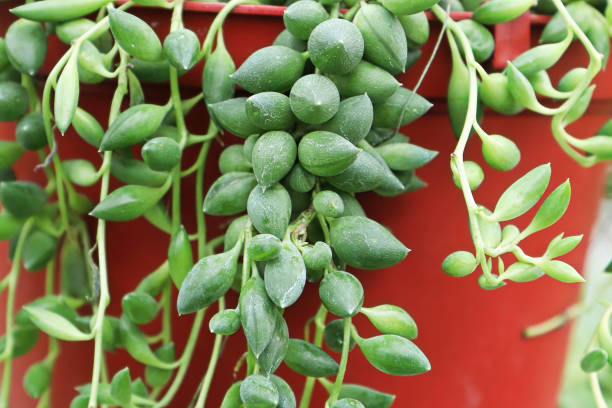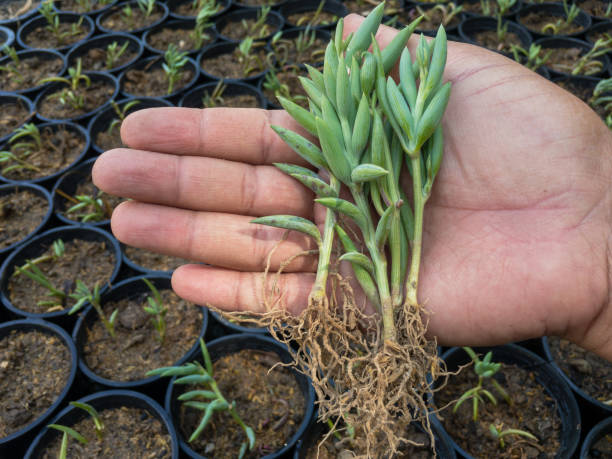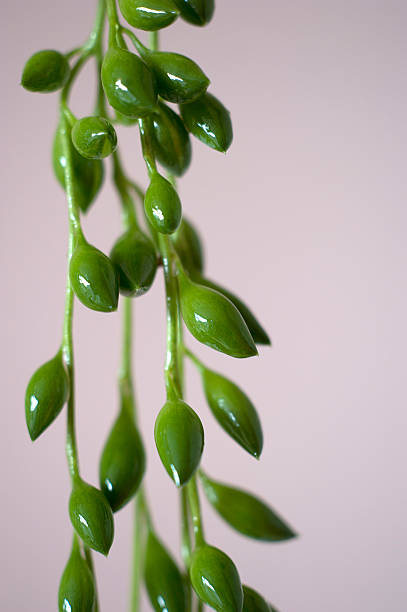
If you’re looking for an easy, low-maintenance houseplant that will add a touch of green to any room, a banana tree may be just what you’re looking for. These plants are hardy and can thrive in various environments, making them perfect for first-time plant owners and experienced gardeners alike. This guide will show you everything you need to know about growing and caring for banana trees, including watering, pruning, and fertilizing tips.
An Overview of the String of Bananas (Senecio Radicans)
The string of bananas is a succulent plant that’s native to South Africa. It gets its name from its long, trailing stems that are covered in small, banana-shaped leaves.
The plant is related to the common houseplant known as the string of pearls and shares many of the same care requirements.
The string of bananas is a fast-growing plant that can reach up to 6 feet in length. It’s an ideal candidate for hanging baskets or trailing down shelves and bookcases.
When given the proper care, the plant will produce small, white flowers that bloom in the spring and summer.
What Makes String of Bananas Different from String of Pearls?
Although they’re both members of the succulent family, a string of bananas is a different plant from a string of pearls.
The two plants have different watering and care requirements, so it’s important to know which one you have before trying to care for it.
A string of bananas is a fast-growing plant that produces long, thin leaves. The leaves are slightly curved and have a yellow stripe down the center. The plant produces small, white flowers that bloom in the summer.
On the other hand, a string of pearls is a slow-growing plant that produces round, bead-like leaves. The leaves are green with white stripes, and the plant produces small, white flowers that bloom in the spring.
If you’re unsure which plant you have, look at the leaves. A string of bananas has long, thin leaves, while a string of pearls has round, bead-like leaves. You can also ask a succulent expert at your local nursery for help identifying the plant.
String of Bananas Watering

The string of bananas is a succulent plant with low water requirements. In general, you should only water the plant when the soil is dry to the touch.
Water thoroughly until water runs out of the drainage holes at the bottom of the pot. Then, allow the plant to drain completely before putting it back in its place.
If you live in a very dry climate, you may need to water the plant more frequently. Conversely, if you live in a humid climate or keep the plant in a high-humidity environment (such as a bathroom), you may need to water it less often.
What does an overwatered string of Bananas look like?
If you overwater your string of bananas, the leaves will start to yellow and fall off. The stems may also become mushy and break easily.
To avoid overwatering, it’s best to err on the side of underwatering. If you’re not sure whether or not to water the plant, it’s better to wait a few extra days than to water it too often.
String of Bananas Soil Requirements
The string of bananas thrives in well-draining, sandy soil. You can either purchase a succulent or cactus potting mix from your local nursery or make your own by mixing equal parts sand and perlite.
If you choose to make your own potting mix, be sure to sterilize the sand and perlite before using them. You can do this by boiling the sand and perlite for 20 minutes, then allowing them to cool completely before mixing them together.
String of Bananas Fertilizer Requirements
The string of bananas is a fast-growing plant so it will benefit from regular fertilization. Use a balanced fertilizer (such as 10-10-10) that’s specifically designed for succulents and cacti.
Fertilize the plant once a month during the spring and summer and every other month during the fall and winter.
Be sure to dilute the fertilizer to half strength before applying it to the plant. Too much fertilizer can burn the roots, so it’s important to follow the manufacturer’s instructions carefully.
How to Propagate the String of Bananas

The string of bananas is relatively easy to propagate from stem cuttings. To do this, use a sharp knife or gardening shears to take a 4-6 inch cutting from a healthy part of the plant.
Remove the bottom leaves from the cutting, then allow them to callus over for a few days before planting them in well-draining soil.
Place the cutting in a warm, sunny location and water it sparingly until new growth appears. Once the plant is established, you can treat it like a mature plant and water it according to the usual care requirements.
Common Pests and Diseases
The string of bananas is generally resistant to pests and diseases, but it can be susceptible to mealybugs and root rot.
Mealybugs are small, white, fuzzy insects that feed on the sap of succulent plants. They can be difficult to control, so it’s best to catch them early.
If you see mealybugs on your plant, you can remove them by dabbing them with a cotton swab dipped in rubbing alcohol. You can also use insecticidal soap or neem oil to control mealybug infestations.
Root rot is caused by too much moisture around the roots of the plant. If the plant is sitting in water or the soil is constantly damp, the roots will start to rot. This can kill the plant, so it’s important to catch root rot early.
Remove the plant from its pot and check the roots if you see signs of root rot (such as yellowing leaves or mushy stems).
If the roots are black or brown, they’re probably rotten. Cut away any rotten roots with a sharp knife, then replant the plant in fresh, well-draining soil.
Light Requirement
The string of bananas prefers bright, indirect light but can tolerate some direct sun. If the plant is getting too much sun, the leaves will start to scorch and turn brown.
If you live in a hot climate, keeping the plant in an area that gets some afternoon shade is best. This will help prevent the leaves from getting sunburned.
Temperature Requirement
The string of bananas is a tropical plant, so it prefers warm temperatures. It can tolerate some cold weather but will dormant in cooler temperatures.
The plant will start to lose its leaves and the stems will become thinner if it’s too cold.
If you live in a cold climate, keeping the plant indoors during the winter is best. You can move it outside when the weather warms up in the spring
How to Pot and Repot String of Bananas?
The string of bananas is a fast-growing plant, so it will need to be repotted every year or two.
Be sure to use a well-draining potting mix and a pot with drainage holes to prevent the roots from rotting.
To repot the plant, gently remove it from its current pot and shake off any excess soil. Cut away any black or brown roots, then replant the plant in a new pot with fresh potting mix.
Water the plant well after repotting and place it in a warm, sunny location. Avoid watering the plant for a week or two to allow the roots to recover from being disturbed.
How to Propagate String of Bananas
String of bananas is relatively easy to propagate from stem cuttings. To do this, use a sharp knife or gardening shears to take a 4-6 inch cutting from a healthy part of the plant. Remove the bottom leaves from the cutting, then allow them to callus over for a few days before planting them in well-draining soil.
Place the cutting in a warm, sunny location and water it sparingly until new growth appears. Once the plant is established, you can treat it like a mature plant and water it according to the usual care requirements.
Common Pests and Diseases

The string of bananas is generally resistant to pests and diseases, but it can be susceptible to mealybugs and root rot.
Mealybugs are small, white, fuzzy insects that feed on the sap of succulent plants. They can be difficult to control, so it’s best to catch them early.
If you see mealybugs on your plant, you can remove them by dabbing them with a cotton swab dipped in rubbing alcohol. You can also use insecticidal soap or neem oil to control mealybug infestations.
Root rot is caused by too much moisture around the roots of the plant. If the plant is sitting in water or the soil is constantly damp, the roots will start to rot. This can kill the plant, so it’s important to catch root rot early.
Remove the plant from its pot and check the roots if you see signs of root rot (such as yellowing leaves or mushy stems).










